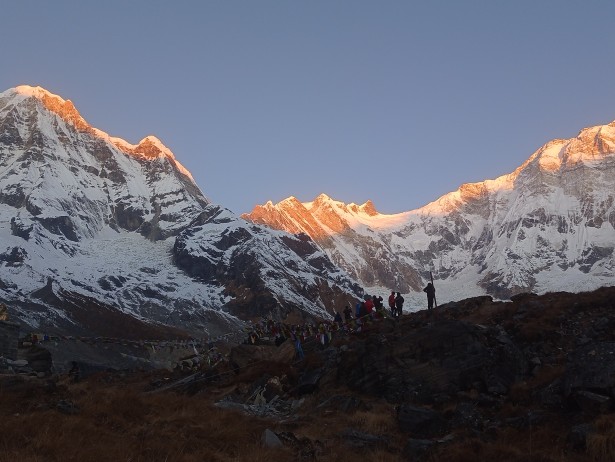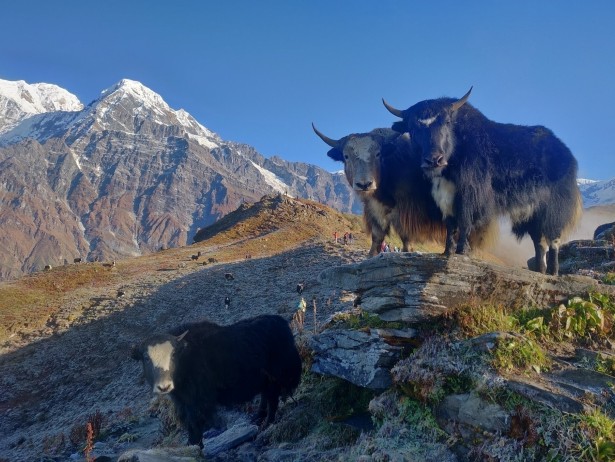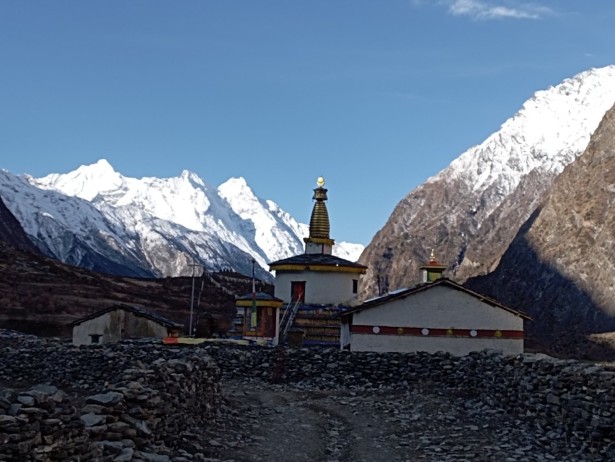Nepal, a tiny yet culturally vibrant Himalayan nation, boasts an impressive diversity in its population, with various castes and over 125 languages. Despite its modest size, it is a rich tapestry woven with these distinct communities. Recently, the Nepali New Year has brought forth the onset of the year 2081, which equates to approximately 56 years and 8 months ahead in the widely adopted Gregorian Calendar or A.D. Lunisolar in origin, the B.S. calendar provides the Nepali people with opportunities to uphold their cultural heritage through diverse rituals and festivities, expressed in resonance with lunar-solar movements.
The unique Nepali Calendar, also known as Bikram Sambat (B.S.) or Vikram Samvat, is a deeply cherished Hindu-based lunisolar calendar. With its long-standing presence in Nepal, it has enabled the preservation of rich cultural traditions harmoniously integrated with the cycles of the moon and sun. As the New Year unfolds, the Newar community from Bhaktapur – a prominent Nepali community – celebrates their annual Biska Jatra (festival) on the onset of the first month of the Nepali Calendar, Baisakh.
The third season, extending from September to November brings forth a captivating sequence of festivals in Nepal. This festive season in Nepal is a dazzling spectacle of diverse traditions, fostering unity and refreshing motivation.
Here are some of the most prominent celebrations:
Major festivals of Nepal
Chaite Dashain (Chaitra Dashain):
This festival is popularly known as a Small Dashain which is celebrated in April (Chaitra or Baishak) depending on the Nepali calendar, indicating the end of the winter season and the start of spring. This festival takes place for two days and the various communities celebrate according to their traditions. It holds and reflects the country’s cultural and traditional significance and values.
Rato Machindranath Jatra:
Machindranath is known more as an agricultural scientist than a god. It is one of the longest festivals in Nepal held for a month where people pull the Machindranath’s chariot and pray for rain and prosperity.
This festival is mainly celebrated by the Newari community and within the Kathmandu valley. It was introduced by Narendra Dev Malla in 879 AD. The Newari people commence the festival with a grand worshiping of the Machindranath chariot which is approximately 60 ft. tall and decorated with seasonal flowers, flags, and colors. The chariot is then taken through a predetermined route starting from Natole, Jawalakhel via Gabahal, Mangalbazar, Sundhara, Lagankhel, Kumaripati and finally stopping at Jawalakhel, where the Living Goddess Kumari graces her presence among the masses and to oversee the Bhote Jatra.
Bajrayogini Jatra:
This festival is predominantly celebrated by the Newars of the Kathmandu Valley who follow Vajrayana Buddhism. It falls on the 3rd of the first month of the Nepali calendar ’Baisakh’. The temple of Bajrayogini lies in the lap of hills and once a year the locals carry the idol of the Goddess and bring it to the city to bring peace, prosperity, and purification. The celebration happens on the full moon when people worship the Goddess with the three red eyes.
Buddha Jayanti:
The nationwide celebration of the birth, enlightenment, and death of Lord Buddha in May. Buddha is known as the symbol of wisdom and compassion of the people and the path shower to all those who follow his teachings and guidelines.
Janai Purnima:
One of the holiest traditions of Hindus, Janai Purnima is celebrated in Bhadra (Sep-Oct). Hindu men renew their 'Janai' a sacred thread on their bodies and do puja (ritual) to get protection from negative energy. On this day, both Hindu men and women get a thread (yellow, red, and orange colors) tied around their wrists by a priest in Temples and surrounding areas.
Another festival called ‘Rakshyabandhan’ falls on the same day, where sisters tie a thread decorated with jewels and colors on their brother’s wrist and pray for their protection and a long-lasting relationship. In exchange, the brothers give their sisters gifts and money. It is mainly celebrated in the neighboring country, India, and in recent years has been commonly celebrated in Nepal as well.
Indra Jatra:
Indra Jatra is also known as ‘Yenya’ in the Newari language. It is mainly dedicated to the Hindu god ‘Indra’ (King of Heaven) to mark the end of the monsoon and is celebrated in the capital city of Kathmandu. The main highlights of the festival are the colorful processions, mask dance, participation of various Newari community clubs playing traditional instruments, placements of lavishly decorated Samay baji – an authentic traditional Newari dish, and erection of a ceremonial pole known as 'Linga' and so on. It is celebrated for 8 days long in September.
Dashain:
The longest and one of the most significant Hindu festivals celebrated by most of the Nepalese communities. Dashain often referred to as ‘Vijaya Dashami’, lasts for 15 days. The festival commences with the first day known as ‘Ghatasthapana’ where people plant barley seeds in a clay pot to grow ‘Jamara’ (barley sprouts). Each subsequent day such as Fulpati, Mahaastami, Nawami, and Vijaya Dashami is a sequence of events within Dashain, each holds unique sets of rituals dedicated to different deities, including the worship of symbols like sacred water vessels, the power of nature, the Hindu goddess Durga.
Typically, on the tenth day, Vijaya Dashami also known as tika day, Nepalese worship goddess Durga, and elders distribute sacred tika (red vermilion) and Jamara (barley sprouts) to signify blessings and protection. It is a time when families from far and near come together, wear new clothes, exchange gifts, and indulge in delicious traditional food.
During Dashain, Nepalese communities come together to honor the victory of good over evil. The festival signifies the commemoration of Lord Ram's victory over the demon king Ravana in a mythological tale, representing the triumph of righteousness. It usually falls between September and October, depending on the Nepali calendar (lunar calendar).
Tihar:
Also known as Deepawali or the Festival of Lights is one of the major Hindu and Nepalese festivals celebrated during October or November each year. This festival lasts for 5 days and is dedicated to honoring Lakshmi, the goddess of wealth, for prosperity, and good fortune, and to eliminate the obstacles. Within the 5-day-long festival, different animals such as Crows, Dogs, Cows, and Ox are worshipped from the first to the fourth day respectively.
These religious occasions are accompanied by various traditions, such as lighting oil/butter lamps, making rangoli, decorating the houses and offices with colorful lights, bursting firecrackers, exchanging sweets and traditional food items, and wearing new clothes. On the third and the fourth days, people play ‘Deusi and Bhailo’ in groups by going door-to-door, singing traditional songs, reciting specific verses, offering prayers to the household deities, and receiving monetary offerings and food items in return.
‘Bhai Tika’ is observed on the fifth and the last day of the Tihar festival. This day is dedicated to the bond between siblings, emphasizing the love and care between brothers and sisters. On this day, sisters put a sacred tika of rice, colored powder, and vermilion on their brothers' foreheads, seeking their blessings for long life, prosperity, and protection. Brothers, in turn, reciprocate by giving their sisters gifts, clothing, jewelry, or other tokens of love and appreciation.
The fifth day of Tihar, referred to as ‘Bhai Tika’, is a special occasion that celebrates the bond between brothers and sisters. This ritual emphasizes the significance of affection and care that exists between siblings. On this day, sisters put the ‘saptarangi tika’ (seven-colored tika – colors of a rainbow) on their brothers’ forehead wishing for their longevity, and wealth, and seeking protection from harm in return. In response, brothers bless their sisters by showering them with gifts, new clothing, jewelry, and expressions of love and affection.
Chhath Parva:
Chhath Puja is another major Hindu festival celebrated primarily in the Terai belt and by the communities of the Maithili regions of Nepal. It is a four-day festival dedicated to the sun god, Surya, and his consort, Chhathi Maiya or Usha. The Sun considered the god of energy and of the life force, is worshipped during the Chhath festival to promote well-being, prosperity, and progress. It typically takes place during October or November, following the Nepali calendar.
Amid the festival, devotees adhere to a strict fast to carry out different spiritual practices. These traditional rituals include presenting arghya (a type of water offering), performing sandhyas (collection of prayers at specific times), and distributing ‘prasad’ (blessed offerings) among kin, companions, and neighbors.
Maghe Sankranti:
Marks the end of the winter solstice and the beginning of longer days. The Tharu community celebrates this day as the New Year and it is also the annual festival of the Magar community. The main rituals include cultural activities, feasting, and taking holy dips in rivers and ponds. Some popular traditions include the preparation and consumption of sesame oil, sesame laddoos, ghee (clarified butter), sweet potatoes, and chaku (made from concentrated sugarcane juice, jaggery, ghee, and nuts).
Shiva Ratri:
The cherished Hindu festival, Shivaratri, is an annual observance dedicated to the revered deity Lord Shiva, who represents destruction and regeneration and is described as the god of auspiciousness and blessings. Following the Hindu lunisolar calendar, Shivaratri is celebrated on the 14th night during the Krishna Paksha (the waning phase of the moon) in the Hindu calendar month of Falgun (February or March).
For avid devotees of Lord Shiva, this festival carries profound significance and is commemorated with acts of devotion, including rigorous fasting, delving into spiritual practices such as yoga, repeatedly chanting the powerful Mahamrityunjaya Mantra, and observing a peaceful vigil throughout the night at Shiva temples.
Moreover, the festival extends beyond its religious context and becomes a prominent social event. Families and friends come together during Shivaratri, partaking in communal rituals like lighting bonfires, sharing scrumptious meals, and reinforcing their bonds amidst a profoundly spiritual ambiance.
Delve into the heartbeat of the Himalayas and join us to get the full experience of a vibrant display of local culture, traditional music, and colorful processions of the festivals in Nepal! Don't miss this unique opportunity to immerse yourself in a celebration that brings together both the divine and the communal spirit of Nepal. Be part of something truly magical. See you in Kathmandu!
Come and witness the grandeur of Nepalese tradition and culture!









